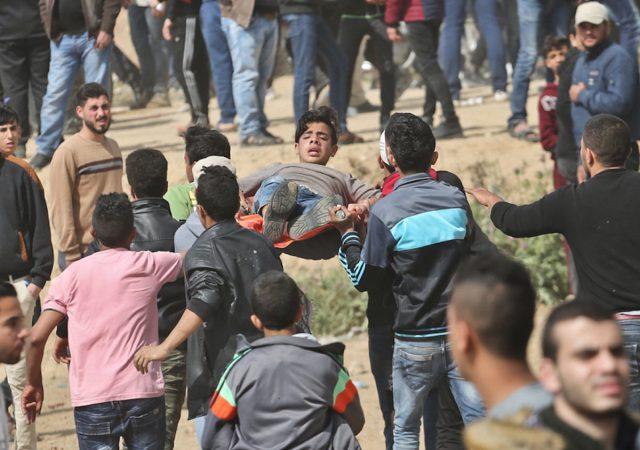
Events on the Gaza–Israel border during the past few days clearly demonstrate the irrelevance of the two-state solution to the Israel–Palestine conflict. On 30 March, as many as 30,000 Palestinians gathered at several points on the border between Israel and Gaza to observe the beginning of a six-week peaceful protest to mark ‘Land Day’ against the Israeli acquisition of Palestinian lands both within Israel and in the occupied territories.
Pent-up Palestinian frustrations—especially the consequence of the economic blockade imposed on Gaza by Israel for the past several years—conjoined with anger against Israeli denial for 70 years of the Palestinians’ right to return to their homes within Israel, soon led to acts of tire burning and stone throwing at Israeli troops posted on the border. This led to Israeli retaliation with live ammunition that left 15 Palestinian young men dead and possibly 1,000 wounded.
Despite these casualties the Palestinians are in no mood to leave their encampments on the border and further fatalities can be expected over the next few days. This demonstration of Palestinian rage is targeted both against Israeli oppression and the infirmity and irrelevance of the Palestinian Authority.
It’s also a rebuke aimed at Hamas, which rules Gaza, and the eternal feuding between PLO/Fatah and Hamas that has weakened their bargaining position vis-à-vis Israel. In fact, this feud has played into Israeli hands by allowing it to successfully make the argument that it doesn’t have a Palestinian counterpart with whom it can negotiate peace.
The Gaza demonstrations are above all a rejection of the two-state solution. They’re increasingly focused on the Palestinians’ demand for the return to their homes, from which they were evicted in 1948. This demand resonates especially in Gaza. Seventy percent of Gaza’s inhabitants are refugees of the 1948 Nakba (tragedy) and their descendants.
A two-state solution doesn’t provide a solution either for their yearning to return to their original homes or for the abject poverty and economic distress from which they suffer in Gaza.
Moreover, the situation in the occupied territories makes it clear that an independent Palestinian state is no longer on the cards because the West Bank has been Balkanised and Jewish settlements and settler-only roads constructed in ways that make it impossible for a contiguous and viable state to emerge.
Additionally, Israel’s unyielding demand for a military presence on the Jordanian border, as well as a totally disarmed Palestinian state, would leave the rump Palestine state absolutely defenceless and at the mercy of its Jewish neighbour, a situation not very different from the one currently prevailing in the occupied territories.
The change in the primary Palestinian demand from a two-state solution to the right of return to a single state between the Jordan River and the Mediterranean Sea has been on the cards for the past several years. It will mean sacrificing the Palestinian goal of national self-determination.
However, it will also advance the implementation of the ideal for which the Palestinian national movement had fought in the 1940s, namely the creation of one state between the river and the sea with equal rights for all its citizens.
Recently, senior PLO figure and veteran Palestinian negotiator Saeb Erekat has endorsed the one-state idea, which is gaining traction among substantial segments of the Palestinian leadership. This change in vision among some members of the Palestinian leadership has to do in part with the realisation that Israel will never allow a viable Palestinian state to emerge.
But, in part it also has to do with the realisation among Palestinians that a two-state solution won’t resolve the problem of the Palestinian refugees’ right to return.
Such a stance, if adopted officially by PLO/Fatah, will throw the Israeli political elite into a quandary. The only alternative to a bi-national and multi-religious state will be a state based on apartheid, both in law and in fact, where civil and political rights are reserved for only one ethnic group and the dominant-subordinate relationship is codified in legal terms.
This will be unacceptable to the large majority of the international community. Even American support for Israel will not be enough to save it from international opprobrium and economic sanctions à la South Africa.
However, for such a situation to emerge, a leadership change in the PLO/Fatah will be absolutely essential. The octogenarian Mahmoud Abbas is out of tune with the current thinking among younger Palestinians. A change in the PLO leadership and mindset will also help close the ideological gap between Fatah and Hamas, which rejects the Oslo process and, consequently, the two-state solution.
A simultaneous change in the Hamas approach will also be essential. Hamas must shed its Islamist ideological rigidity and concentrate on the demand for the refugees’ right of return to a single state. This will further endear it to the Gazans over whom it rules.
The Palestinians have now reached a crossroad where it’s essential for them to choose the correct path for their future. For this they need an astute leadership, which is in short supply in both the PLO and Hamas, but one which hopefully will emerge from spontaneous outbursts and autonomous actions such as the current Gaza demonstrations.